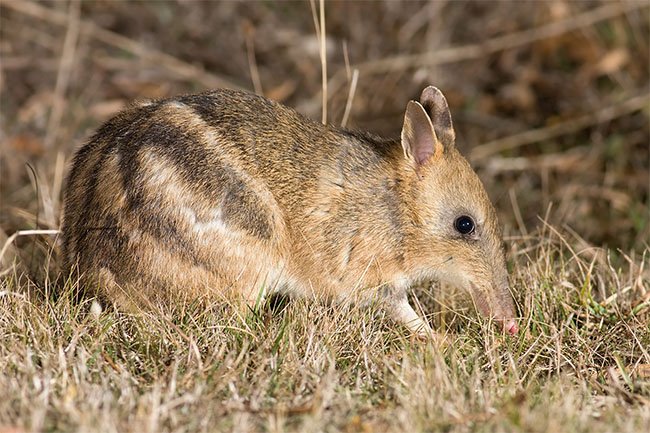Bandying about with Marsupials
Ellen Rykers, CC BY 4.0, via Wikimedia Commons
Peramelemorphia
by Inspector Barry Mins on September 20, 2022Hey kids, welcome back to our series on the mysteries of created kinds.
This week, we move from southeast Asia into Australia and Papua New Guinea. Being that it is Australia, we are looking for marsupials.

The species in this kind are largely rare and endangered. As such, they are the focus of conservation efforts in much of their home range.1 Several species are known only from a few specimens.2 Some reintroductions have failed due to introduced predators, but others have been at least mildly successful.3
This kind loves to dig. Its forelimbs are specially designed to dig in the dirt.4 They tend to be omnivores, munching on plants and insects.5 Because their foraging generally involves digging, they turn over the soil effectively as they look for food.6 They tend to prefer open areas without brush or leaf litter.7 They are primarily nocturnal but will come out during the day at times.8
Males tend to be larger than females. Birth tends to occur year-round, except in the autumn (keep in mind, in Australia, autumn is April–June).9 Litter size tends to be around two or three and gestation is around 12 1/2 days.10
Has anyone figured it out yet? This week’s kind is the Peramelemorphia—the bandicoots. Stay tuned for next week when we go looking for a single species of bird from north Africa and the Middle East.

Eastern Barred Bandicoot
JJ Harrison (https://www.jjharrison.com.au/), CC BY-SA 3.0, via Wikimedia Commons
Try out this fun crossword!
Clue
Here is your clue for next week:
When translated from Latin, the genus and species name of this kind means “dark tail restless.”
Ask a Question
Have you ever had a question about created kinds but didn’t know who to ask? Have you ever wanted to learn more about your favorite kind? Well, now you can! You can ask me, Inspector Barry Mins, a question! Have your parents help you fill out this form, and you might get your question answered in my column! If you have any questions about created kinds, feel free to send them my way!
Footnotes
- A. L. Winnard and G. Coulson, “Sixteen years of Eastern Barred Bandicoot Perameles gunnii reintroductions in Victoria: a review,” Pacific Conservation Biology 14, no. 1 (2008), 34–53.
- K. M. Helgen and T. F. Flannery, “A new species of bandicoot, Microperoryctes aplini from western New Guinea,” Journal of the Zoological Society of London 264, no. 2 (February 2004), 117–124.
- J. D. Richards and J. Short, “Reintroduction and establishment of the western barred bandicoot Perameles bougainville (Marsupialia: Peramelidae) at Shark Bay, Western Australia,” Biological Conservation 109 (2003), 181–195.
- N. M. Warburton, L. Gregoire, S. Jacques, and C. Flandrin, “Adaptations for digging in the forelimb muscle anatomy of the southern brown bandicoot (Isoodon obesulus) and bilby (Macrotis lagotis),” Australian Journal of Zoology 61, no. 5 (December 23, 2013), 402–419, https://doi.org/10.1071/ZO13086.
- D. G. Quinn, “Observations on the diet of the southern brown bandicoot, Isoodon obesulus (Marsupialia: Peramelidae), in southern Tasmania,” Australian Mammal 11 (1985), 15–25.
- L. E. Valentine, H. Anderson, G. E. St. J. Hardy, and P. A. Fleming, “Foraging activity by the southern brown bandicoot (Isoodon obesulus) as a mechanism for soil turnover,” Australian Journal of Zoology 60, no. 6 (2012), 419–423.
- L. K. Chambers and C. R. Dickman, “Habitat selection of the long-nosed bandicoot Perameles nasuta (Mammalia, Peramelidae) in a patchy urban environment,” Austral Ecology 27, no. 3 (2002), 334–342.
- R. J. Cuthbert and M. J. H Denny, “Aspects of the ecology of the kalubu bandicoot (Echymipera kalubu) and observations on Raffray’s bandicoot (Peroryctes raffrayanus), Eastern Highlands Province, Papua New Guinea,” Australian Mammalogy 36, no. 1 (September 13, 2013), 21–28.
- R. T. Gemmell, “Breeding bandicoots in Brisbane (Isoodon macrourus; Marsupialia, Peramelidae),” Australian Mammalogy 5, no. 3 (1982), 187–193.
- A. G. Lyne, “Gestation period and birth in the marsupial Isoodon macrourus,” Australian Journal of Zoology 22, no. 3 (1974), 303–309.
- © 2024 Answers in Genesis
- Privacy Policy
- Contact
- About
